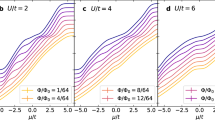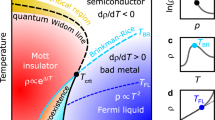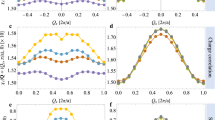Abstract
The competition between kinetic energy and Coulomb interactions in electronic systems leads to complex many-body ground states with competing orders. Here we present zinc oxide-based two-dimensional electron systems as a high-mobility system to study the low-temperature phases of strongly interacting electrons. An analysis of the electronic transport provides evidence for competing correlated metallic and insulating states with varying degrees of spin polarization. Some features bear quantitative resemblance to quantum Monte Carlo simulation results, including the transition point from the paramagnetic Fermi liquid to Wigner crystal and the absence of a Stoner transition. At very low temperatures, we resolve a non-monotonic spin polarizability of electrons across the phase transition, pointing towards a low spin phase of electrons, and a two-order-of-magnitude positive magnetoresistance that is challenging to understand within traditional metallic transport paradigms. This work establishes zinc oxide as a platform for studying strongly correlated electrons in two dimensions.
This is a preview of subscription content, access via your institution
Access options
Access Nature and 54 other Nature Portfolio journals
Get Nature+, our best-value online-access subscription
$29.99 / 30 days
cancel any time
Subscribe to this journal
Receive 12 print issues and online access
$259.00 per year
only $21.58 per issue
Buy this article
- Purchase on Springer Link
- Instant access to full article PDF
Prices may be subject to local taxes which are calculated during checkout




Similar content being viewed by others
Data availability
The data that support the findings of this study are available from the corresponding author on request.
References
Tanatar, B. & Ceperley, D. M. Ground state of the two-dimensional electron gas. Phys. Rev. B 39, 5005–5016 (1989).
Rapisarda, F. & Senatore, G. Diffusion Monte Carlo study of electrons in two-dimensional layers. Aust. J. Phys. 49, 161–182 (1996).
Phillips, P., Wan, Y., Martin, I., Knysh, S. & Dalidovich, D. Superconductivity in a two-dimensional electron gas. Nature 395, 253–257 (1998).
Chamon, C., Mucciolo, E. R. & Castro Neto, A. H. P-wave pairing and ferromagnetism in the metal-insulator transition in two dimensions. Phys. Rev. B 64, 245115 (2001).
Attaccalite, C., Moroni, S., Gori-Giorgi, P. & Bachelet, G. B. Correlation energy and spin polarization in the 2D electron gas. Phys. Rev. Lett. 88, 256601 (2002).
Spivak, B. & Kivelson, S. A. Phases intermediate between a two-dimensional electron liquid and Wigner crystal. Phys. Rev. B 70, 155114 (2004).
Drummond, N. D. & Needs, R. J. Phase diagram of the low-density two-dimensional homogeneous electron gas. Phys. Rev. Lett. 102, 126402 (2009).
Spivak, B., Kravchenko, S. V., Kivelson, S. A. & Gao, X. P. A. Colloquium: transport in strongly correlated two dimensional electron fluids. Rev. Mod. Phys. 82, 1743–1766 (2010).
Abrahams, E., Kravchenko, S. V. & Sarachik, M. P. Metallic behavior and related phenomena in two dimensions. Rev. Mod. Phys. 73, 251–266 (2001).
Kravchenko, S. V. & Sarachik, M. P. Metal-insulator transition in two-dimensional electron systems. Rep. Prog. Phys. 67, 1–44 (2003).
Shashkin, A. A. & Kravchenko, S. V. Recent developments in the field of the metal–insulator transition in two dimensions. Appl. Sci. https://doi.org/10.3390/app9061169 (2019).
Dolgopolov, V. T. Two-dimensional system of strongly interacting electrons in silicon (100) structures. Phys. Usp. 62, 633–648 (2019).
Yoon, J., Li, C. C., Shahar, D., Tsui, D. C. & Shayegan, M. Wigner crystallization and metal-insulator transition of two-dimensional holes in GaAs at B = 0. Phys. Rev. Lett. 82, 1744–1747 (1999).
Hossain, M. S. et al. Observation of spontaneous ferromagnetism in a two-dimensional electron system. Proc. Natl Acad. Sci. USA 117, 32244–32250 (2020).
Falson, J. et al. MgZnO/ZnO heterostructures with electron mobility exceeding 1 × 106 cm2/Vs. Sci. Rep. 6, 26598 (2016).
Falson, J. & Kawasaki, M. A review of the quantum Hall effects in MgZnO/ZnO heterostructures. Rep. Prog. Phys. 81, 056501 (2018).
Maryenko, D. et al. Interplay of spin–orbit coupling and Coulomb interaction in ZnO-based electron system. Nat. Commun. 12, 3180 (2021).
Kozuka, Y. et al. Rashba spin-orbit interaction in a MgxZn1−xO/ZnO two-dimensional electron gas studied by electrically detected electron spin resonance. Phys. Rev. B 87, 205411 (2013).
Falson, J. et al. Even denominator fractional quantum Hall physics in ZnO. Nat. Phys 11, 347–351 (2015).
Falson, J. et al. A cascade of phase transitions in an orbitally mixed half-filled Landau level. Sci. Adv. 4, eaat8742 (2018).
Shklovskii, B. I. & Efros, A. L. Electronic Properties of Doped Semiconductors (Springer, 1984).
Shklovskii, B. I. Coulomb gap and variable range hopping in a pinned Wigner crystal. Phys. Status Solidi C 1, 46–50 (2004).
Zala, G., Narozhny, B. N. & Aleiner, I. L. Interaction corrections at intermediate temperatures: magnetoresistance in a parallel field. Phys. Rev. B 65, 020201 (2001).
Zala, G., Narozhny, B. N. & Aleiner, I. L. Interaction corrections at intermediate temperatures: longitudinal conductivity and kinetic equation. Phys. Rev. B 64, 214204 (2001).
Knighton, T. et al. Evidence of two-stage melting of Wigner solids. Phys. Rev. B 97, 085135 (2018).
Kravchenko, S. V., Simonian, D., Sarachik, M. P., Mason, W. & Furneaux, J. E. Electric field scaling at a B = 0 metal-insulator transition in two dimensions. Phys. Rev. Lett. 77, 4938–4941 (1996).
Das Sarma, S. & Hwang, E. H. Low-density finite-temperature apparent insulating phase in two-dimensional semiconductor systems. Phys. Rev. B 68, 195315 (2003).
Matveev, K. A., Glazman, L. I., Clarke, P., Ephron, D. & Beasley, M. R. Theory of hopping magnetoresistance induced by Zeeman splitting. Phys. Rev. B 52, 5289–5297 (1995).
Chakravarty, S., Kivelson, S., Nayak, C. & Voelker, K. Wigner glass, spin liquids and the metal-insulator transition. Phil. Mag. B 79, 859–868 (1999).
Bernu, B., Cândido, L. & Ceperley, D. M. Exchange frequencies in the 2D Wigner crystal. Phys. Rev. Lett. 86, 870–873 (2001).
Bernu, B., Delyon, F., Holzmann, M. & Baguet, L. Hartree-Fock phase diagram of the two-dimensional electron gas. Phys. Rev. B 84, 115115 (2011).
Bernu, B., Delyon, F., Baguet, L. & Holzmann, M. Periodic ground states of the electron gas in two and three dimensions. Contrib. Plasma Phys. 57, 524–531 (2017).
Jamei, R., Kivelson, S. & Spivak, B. Universal aspects of Coulomb-frustrated phase separation. Phys. Rev. Lett. 94, 056805 (2005).
Spivak, B. & Kivelson, S. A. Transport in two dimensional electronic micro-emulsions. Ann. Phys. 321, 2071–2115 (2006).
Li, S., Zhang, Q., Ghaemi, P. & Sarachik, M. P. Evidence for mixed phases and percolation at the metal-insulator transition in two dimensions. Phys. Rev. B 99, 155302 (2019).
Andrei, E. Y. et al. Observation of a magnetically induced Wigner solid. Phys. Rev. Lett. 60, 2765–2768 (1988).
Ye, P. D. et al. Correlation lengths of the Wigner-crystal order in a two-dimensional electron system at high magnetic fields. Phys. Rev. Lett. 89, 176802 (2002).
Smolenski, T. et al. Signatures of Wigner crystal of electrons in a monolayer semiconductor. Nature 595, 53–57 (2021).
Zhou, Y. et al. Bilayer Wigner crystals in a transition metal dichalcogenide heterostructure. Nature 595, 48–52 (2021).
Jang, J., Hunt, B. M., Pfeiffer, L. N., West, K. W. & Ashoori, R. C. Sharp tunnelling resonance from the vibrations of an electronic Wigner crystal. Nat. Phys. 13, 340–344 (2017).
Pan, W. et al. Exact quantization of the even-denominator fractional quantum Hall state at ν = 5/2 Landau level filling factor. Phys. Rev. Lett. 83, 3530–3533 (1999).
Samkharadze, N. et al. Integrated electronic transport and thermometry at millikelvin temperatures and in strong magnetic fields. Rev. Sci. Instrum. 82, 053902 (2011).
Acknowledgements
We appreciate discussions with I. Aleiner, J. Checkelsky, S. Das Sarma, N. Drummond, J. Eisenstein, S. Kivelson, C. Murthy, B. Narozhny, B. Spivak and A. Young, along with technical support from J.-S. Xia, N. Sullivan, G. Euchner and S. Wahl. J.F. acknowledges support from the Max Planck Institute, University of British Columbia and University of Tokyo Center for Quantum Materials; the Deutsche Forschungsgemeinschaft (FA 1392/2-1); and the Institute for Quantum Information and Matter, a National Science Foundation Physics Frontiers Center (grant PHY-1733907). B.S. acknowledges support from the National Science Foundation under grant DMR-2045742. Y.K. acknowledges the Japan Science and Technology Agency, PRESTO grant number JPMJPR1763, Japan. M.K. acknowledges the financial support of the Japan Science and Technology Agency, CREST grant number JPMJCR16F1, Japan.
Author information
Authors and Affiliations
Contributions
J.F. and D.T. gathered experimental data. J.F. performed the molecular beam epitaxy with assistance from Y.K., A.T. and M.K. J.F., I.S. and B.S. wrote the manuscript. All authors discussed the results and commented on the manuscript.
Corresponding author
Ethics declarations
Competing interests
The authors declare no competing interests.
Additional information
Peer review information Nature Materials thanks Rui-Rui Du, Raymond Ashoori and the other, anonymous, reviewer(s) for their contribution to the peer review of this work.
Publisher’s note Springer Nature remains neutral with regard to jurisdictional claims in published maps and institutional affiliations.
Supplementary information
Supplementary Information
Supplementary Figs. 1–15, Table 1 and Discussion.
Rights and permissions
About this article
Cite this article
Falson, J., Sodemann, I., Skinner, B. et al. Competing correlated states around the zero-field Wigner crystallization transition of electrons in two dimensions. Nat. Mater. 21, 311–316 (2022). https://doi.org/10.1038/s41563-021-01166-1
Received:
Accepted:
Published:
Issue Date:
DOI: https://doi.org/10.1038/s41563-021-01166-1
This article is cited by
-
Direct observation of a magnetic-field-induced Wigner crystal
Nature (2024)
-
Spin independence of the strongly enhanced effective mass in ultra-clean SiGe/Si/SiGe two-dimensional electron system
Scientific Reports (2023)
-
A long-sought regime of electronic behaviour
Nature Materials (2022)



